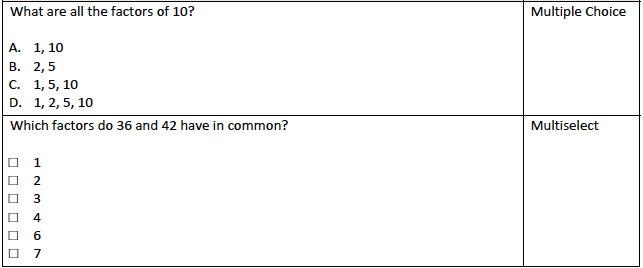Investigate factors and multiples.
a. Find all factor pairs for a whole number in the range 1–100.
b. Recognize that a whole number is a multiple of each of its factors. Determine whether a given whole number in the range 1–100 is a multiple of a given one-digit number.
c. Determine whether a given whole number in the range 1–100 is prime or composite.
Students are able to…
- Extend their understanding of multiplication and division facts to determine factors of given numbers.
- Discuss patterns as they factor a number.
- List numbers of a given value using skip counting and other strategies.
- Identify and describe prime and composite numbers.
Students are able to…because teachers…
- Provides opportunities in which students model arrays to find factor pairs of a given number.
- Provide opportunities for students to discuss patterns in factor lists.
- Provide a variety of tasks for students to explore finding multiples by skip counting and relating multiples to the product of a number.
- Have students connect factors to identifying prime and composite numbers.
- Develop mathematical language including factor, factor pair, multiple, prime, composite, odd and even.
Questions to ask students:
- What is a factor?
- Sample answer that indicates understanding: a factor is a number that when multiplied with another number gives a product.
- What is a factor pair for the number 12? How do you know?
- Sample answer that indicates understanding: Factor pairs include 1 × 24, 2 × 12, 3 × 8, and 4 × 6.
- What is a multiple?
- Sample answer that indicates understanding: A multiple of a given number is the number itself multiplied by another factor. The multiple is the product.
- What are the first 3 multiples of 4? How do you know?
- Sample answer that indicates understanding: The first 3 multiples of 4 are 4, 8, and 12. The first multiple is the product of 1×4=4, the second multiple is the product of 2×4=8, and the third multiple is the product of 3×4=12.
- How are factors and multiples related?
- Sample answer that indicates understanding: Factors are the numbers being multiplied and the multiple is the product of a given factor. (Factor x Factor = Multiple)
- Is the number 24 prime or composite? How do you know?
- Sample answer that indicates understanding: The number 24 is composite because it has more than 2 factors: 1, 2, 3, 4, 6, 8, 12, 24. To be prime there are only 2 factors, 1 and itself.
FSA Notes
Cognitive Complexity Level: 2-Basic Application of Skills & Concepts
Achievement Level Descriptors:
2. finds factor pairs for numbers in the range of 1 to 100, and determines whether a whole number in the range of 1 to 100 is prime or composite, given visual representations
3. finds all factor pairs for whole numbers in the range of 1 to 100; recognizes that a whole number is a multiple of each of its factors; determines whether a whole number in the range of 1 to 100 is prime or composite
4. determines common factors and multiples of numbers in the range of 1 to 100
5. applies the concepts of both factors, multiples, and prime and composite numbers in problem-solving contexts
Assessment Limits:
Items may only contain whole numbers between 1—100.
Vocabulary may include prime, composite, factor, or multiple.
Additional Resources:
Additional in depth content knowledge
Video: Understanding multiples and factors
Understanding prime and composite
Sample Formative Assessment Tasks:
Resources/Tasks to Help Your Child at Home
Choose a number from 1-10 and have your child skip count by that given number to determine the multiples. Could use a 120s chart (https://goo.gl/NngTgc) or a number line (https://goo.gl/G7EHV8) to practice. Then have your child record the multiplication equations and a list of those multiples.
Khan Academy: Factors and Multiples https://goo.gl/1xbcqa
Use a deck of cards to create a 2 digit number. Have your child model all the possible arrays for that given number using any tool: cereal, pennies, etc. Have them record the factors as a list.
Khan Academy: Finding Factors of a Number https://goo.gl/EvMEjd
Use a deck of card or roll a dice to create a 2 digit number. Have your child create arrays and list the factors of the given number. Then determine if the number is prime or composite based on the number of factors.
Khan Academy: Recognizing Prime and Composite https://goo.gl/YJmbkU

